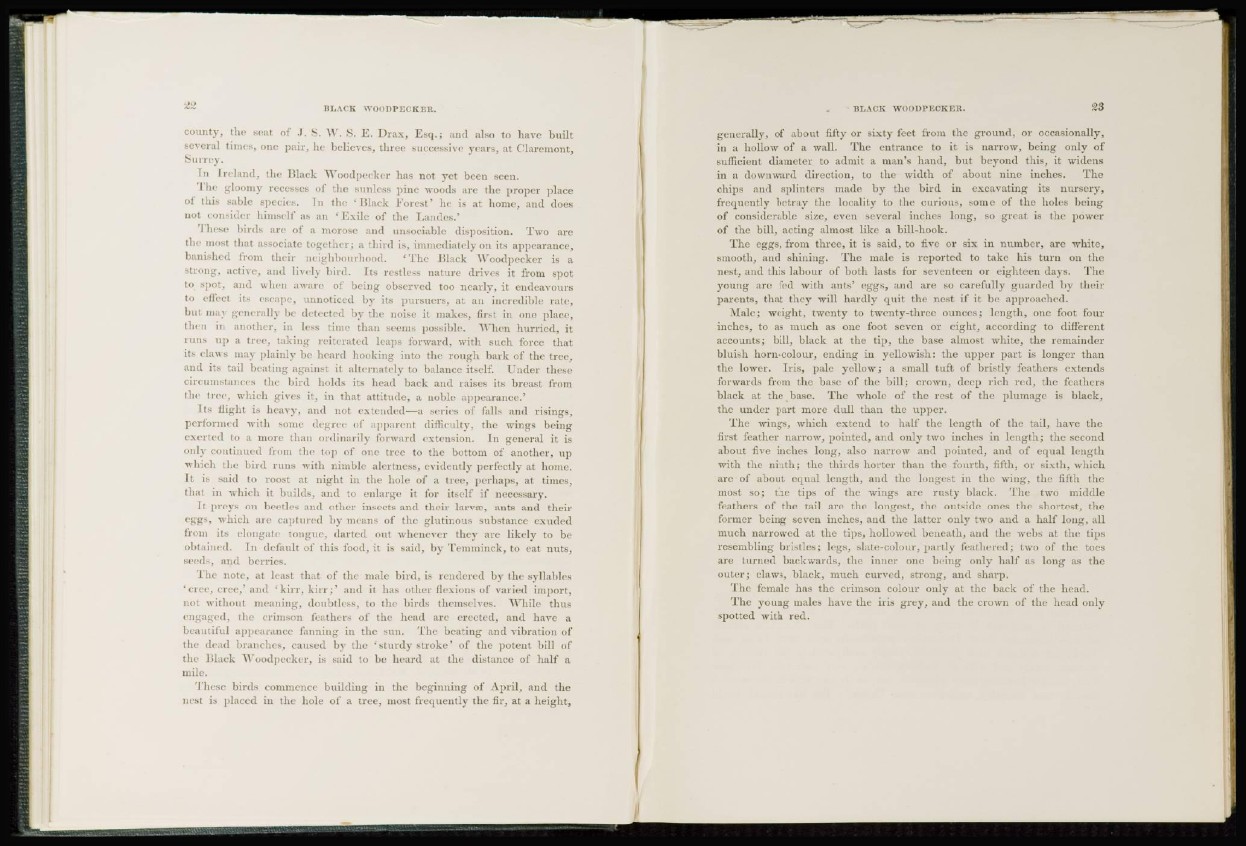
county, the seal of J. S. W. S. K. I)rax, Esq.; ami also to have built
several times, one pair, he believes, three successive years, at Clarcmont,
Surrey.
In Ireland, the Black Woodpecker has not yet been seen.
The gloomy recesses of the sunless pine woods are the proper place
of this sable species. In the 'Black Forest' he is at home, and does
not consider himself as an 'Exile of the Land.es.'
These birds are of a morose and unsociable disposition. Two are
the most that associate together; a third is, immediately on its appearance,
banished from their neighbourhood. ' The Black Woodpecker is a
strong, active, and lively bird. Its restless nature drives it from spot
to spot, and when aware of being observed too nearly, it endeavours
to effect its escape, unnoticed by its pursuers, at an incredible rate,
but may generally he detected by the noise it makes, first in one place,
then in another, in less time than seems possible. When hurried, it
runs up a tree, taking reiterated leaps forward, with such force that
its claws may plainly be heard hooking into the rough bark of the tree,
and its tail beating against it alternately to balance itself. Under these
circumstances the bird holds its head back and raises its breast from
the tree, which gives il. in that attitude, a noble appearance.'
Its flight is heavy, and not extended—a series of falls and risings,
performed with some degree of apparent difficulty, the wings being
exerted to a more than ordinarily forward extension. In general it is
onh continued from the top of one tree to the bottom of another, up
which the bird runs with nimble alertness, evidently perfectly at home.
It is said to roost at night in the hole of a tree, perhaps, at times,
that in which it builds, and to enlarge it for itself if necessary.
It preys en b e e t l e s and other insects and their larva', ants and their
eggs, which are captured by means of the glutinous substance exuded
from its elongate tongue, darted out whenever they are likely to be
obtained. In default of this food, it is said, by Tcmiuinck, to cat nuts,
seeds, and berries.
The note, at least that of the male bird, is rendered by the syllables
'crec, cree,'and 'kirr, kirr;' and it has other flexions of varied import,
not without meaning, doubtless, to the birds themselves. While thus
engaged, the crimson feathers of the head arc erected, and have a
beautiful appearance fanning in the sun. The beating and vibration of
the dead branches, caused by the ' sturdy stroke' of the potent bill of
the Black Woodpecker, is said to be heard at the distance of half a
mile.
These birds commence building in the beginning of April, and the
nest is placed in the hole of a tree, most frequently the fir, at a height,
generally, of about fifty or sixty feet from the ground, or occasionally,
in a hollow of a wall. The entrance to it is narrow, being only of
sufficient diameter to admit a man's hand, but beyond this, it widens
in a downward direction, to the width of about nine inches. The
chips and splinters made by the bird in excavating its nursery,
frequently betray the locality to the curious, some of the holes being
of considerable size, even several inches long, so great is the power
of the bill, acting almost like a bill-hook.
The eggs, from three, it is said, to five or six in number, are white,
smooth, and shining. The male is reported to take his turn on the
nest, and this labour of both lasts for seventeen or eighteen days. The
young are fed with ants' eggs, and are so carefully guarded by their
parents, that they will hardly quit the nest if it be approached.
Male; weight, twenty to twenty-three ounces; length, one foot four
inches, to as much as one foot seven or eight, according to different
accounts; bill, black at the tip, the base almost white, the remainder
bluish horn-colour, ending in yellowish: the upper part is longer than
the lower. Iris, pale yellow; a small tuft of bristly feathers extends
forwards from the base of the bill; crown, deep rich red, the feathers
black at the base. The whole of the rest of the plumage is black,
the under part more dull than the upper.
The wings, which extend to half the length of the tail, have the
first feather narrow, pointed, and only two inches in length; the second
about five inches long, also narrow and pointed, and of equal length
with the ninth; the thirds horter than the fourth, fifth, or sixth, which
are of about equal length, and the longest in the wing, the fifth the
most so; the tips of the wings arc rusty black. The two middle
feathers of the tail are the longest, the outside ones the shortest, the
former being seven inches, and the latter only two and a half long, all
much narrowed at the tips, hollowed beneath, and the webs at the tips
resembling bristles; legs, slate-colour, partlv feathered; two of the toes
are turned backwards, the inner one being only half as long as the
outer; claws, black, much curved, strong, and sharp.
The female has the crimson colour only at the back of the head.
The young males have the iris grey, and the crown of the head only
spotted with red.